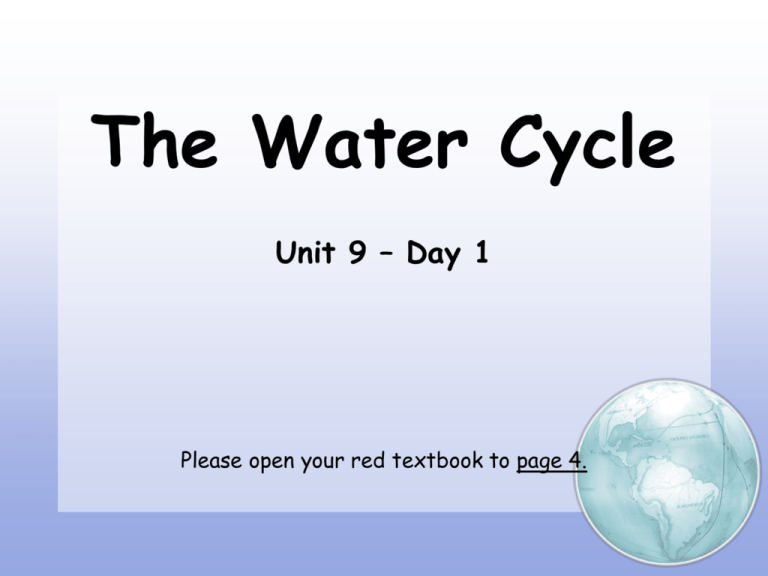The Water Cycle
advertisement

The Water Cycle Unit 9 – Day 1 Please open your red textbook to page 4. The continuous movement of water from the ocean to the atmosphere to the land and back to the ocean Ann Morris, Science Advisory Teacher, PPEC, Neyland. 20.4.02 Did you know that … • there is the same amount of water in the world now as there was hundreds of millions of years ago? So ….. • Where does it come from? • And where does it go? Evaporation • Water in the sea, lakes, rivers, streams, ponds and puddles is heated by the sun. Evaporation • The heated water evaporates to become water vapour. This is light, and floats up into the air – like the steam from a hot cup of tea. Water from the oceans and the Earth’s surface change into water vapor. Energy from the sun causes evaporation. Transpiration • The process of giving off water vapor containing water and waste products through leaves and skin. Plants absorb soilwater through their roots and this water can originate from deep in the soil. Transpiration accounts for approximately 10% of all evaporating water. Condensation • As the water vapour rises into the air, it gradually cools and condenses to form minute droplets of water. • These billions of tiny droplets gather together to form clouds. Water vapor cools and changes into water droplets that form clouds in the atmosphere. Rain When these droplets become too heavy, they fall as rain. Precipitation: Rain, snow, sleet, or hail that falls from the clouds onto the Earth’s land and oceans. Back to the sea • The rainwater flows into streams and rivers and into underground stores. • Eventually, the rivers reach the sea and the cycle starts all over again. Percolation: Downward movement of water through pores and other spaces in soil due to gravity. condensation evaporation Click the cloud to watch the water cycle in action! http://teacher.scholastic.com/activities/studyjams/water_cycle/ Can you fill in the missing words? When water in the sea is heated by the sun it and changes into This is light, and floats up into the air like from a hot cup of tea. steam evaporates water vapour As the rises into the air it gradually cools and to form tiny droplets of water. These join together to make clouds condenses water vapor When the droplets become too heavy, they fall as The rain flows into streams and rivers, and eventually the rivers reach the Now, the cycle WATER CYCLE Day 2 Runoff Runoff is the movement of landwater to the oceans, chiefly in the form of rivers, lakes, and streams. Runoff consists of precipitation that neither evaporates, transpires nor penetrates the surface to become groundwater. Even the smallest streams are connected to larger rivers that carry billions of gallons of water into oceans worldwide. Excess runoff can lead to flooding, which occurs when there is too much precipitation. Water that flows over the ground surface rather than soaking into the ground. + = Water Table? The upper surface of underground water; the upper boundary of the zone of saturation Groundwater is all the water that has penetrated the earth's surface and is found in one of two soil layers. As the amount of groundwater water increases or decreases, the water table rises or falls accordingly. Properties of Water! Boiling Point: 100o C or 212o F Melting Point: 0o C or 32o F Density: 1 g/ml BUT…. What is density?








